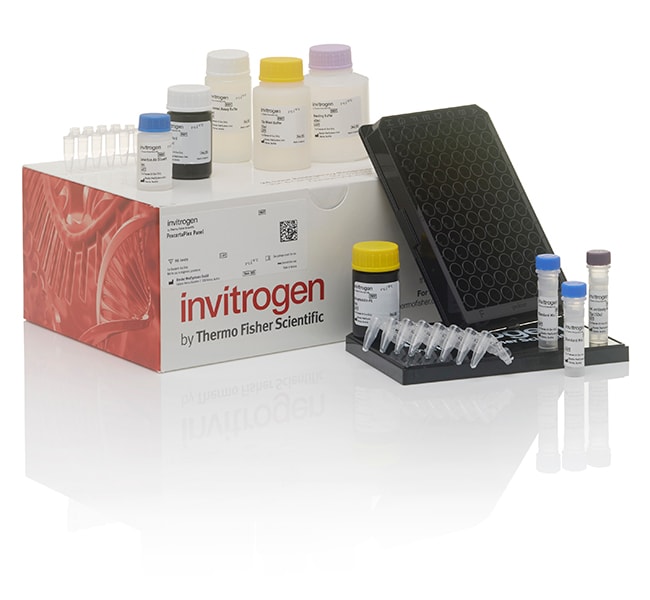Search Thermo Fisher Scientific

ProcartaPlex™ Human Immune Monitoring Panel, 65plex
| Catalog Number | Quantity |
|---|---|
| EPX650-10065-901 | 96 Tests |
The ProcartaPlex Human Immune Monitoring Panel 65plex enables the study of immune function by analyzing 65 protein targets in a single well using Luminex xMAP technology. Analyze 65 cytokine, chemokine, and growth factor targets simultaneously for efficient immune response profiling, biomarker discovery, and validation. The panel is provided in a ready-to-use format with individual vials of capture and detection reagents formulated at 1X concentration, requiring less pipetting and experimental setup. This kit is is not compatible with the MAGPIX instrument. MAGPIX users should use the Human Immune Monitoring Panel for MAGPIX 65plex(Cat. No. EPX650-16500-901) that consists of two separate kits: a 43-plex and a 22-plex kit specifically designed to be used on the MAGPIX instrument that is capable of detecting up to 50 targets simultaneously.
ProcartaPlex preconfigured panels are extensively tested for analyte combinability, interference, and cross-reactivity to provide the highest level of validation and precision. All ProcartaPlex panels are supplied with the necessary reagents to perform the assay.
ProcartaPlex multiplex panels are available in multiple formats across six species (human, mouse, rat, nonhuman primate, porcine, and canine).
Target [bead region]:
Cytokines: G-CSF (CSF-3) [42], GM-CSF [44], IFN alpha [48], IFN gamma [43], IL-1 alpha [62], IL-1 beta [18], IL-2 [19], IL-3 [73], IL-4 [20], IL-5 [21], IL-6 [25], IL-7 [26], IL-8 (CXCL8) [27], IL-9 [52], IL-10 [28], IL-12p70 [34], IL-13 [35], IL-15 [65], IL-16 [70], IL-17A (CTLA-8) [36], IL-18 [66], IL-20 [81], IL-21 [72], IL-22 [76], IL-23 [63], IL-27 [14], IL-31 [37], LIF [15], M-CSF [67], MIF [53], TNF alpha [45], TNF beta [54], TSLP [80]
Chemokines: BLC (CXCL13) [29], ENA-78 (CXCL5) [82], Eotaxin (CCL11) [33], Eotaxin-2 (CCL24) [37], Eotaxin-3 (CCL26) [77], Fractalkine (CX3CL1) [59], Gro-alpha (CXCL1) [61], IP-10 (CXCL10) [22], I-TAC (CXCL11) [57], MCP-1 (CCL2) [51], MCP-2 (CCL8) [8], MCP-3 (CCL7) [68], MDC (CCL22) [87], MIG (CXCL9) [69], MIP-1 alpha (CCL3) [12], MIP-1 beta (CCL4) [47], MIP-3 alpha (CCL20) [56], SDF-1 alpha (CXCL12) [13]
Growth factors/regulators: FGF-2 [75], HGF [46], MMP-1 [64], NGF beta [55], SCF [39], VEGF-A [78]
Soluble receptors: APRIL [88], BAFF [86], CD30 [84], CD40L (CD154) [74], IL-2R (CD25) [22], TNF-RII [85], TRAIL (CD253) [58], TWEAK [97]
About ProcartaPlex assays for the Luminex platform
ProcartaPlex immunoassays are based on the principles of a sandwich ELISA, using two highly specific antibodies binding to different epitopes of one protein to quantitate all protein targets simultaneously using a Luminex instrument. ProcartaPlex multiplex assays require as little as 25 μL of plasma or serum, or 50 μL of cell culture supernatant, and just four hours to obtain analyzed results.
Features include:
• Reproducible, reliable results—validated as a panel to the highest industry standard, including protein target combinability and cross-reactivity testing
• More results per sample—measure multiple protein targets simultaneously in a single 25–50 μL sample
• Well-established Luminex technology highly referenced multiplexing platform for protein detection and quantitation
ProcartaPlex assays utilize Luminex xMAP (multianalyte profiling) technology for the simultaneous detection and quantitation of up to 80 protein targets in a single 25–50 μL sample—from plasma, serum, cell culture supernatants, and other bodily fluids.
QuantiGene RNA testing—one machine, two applications
Gain deeper insight with complementary and highly correlative gene expression and protein assays. With the largest multiplex panel for measurement of protein and RNA, you can now profile more biomarkers with less sample. The Immune Response 80-Plex Human QuantiGene Plex Panel enables efficient immune response profiling and biomarker discovery. Learn more >
• 2 vials Human Standard Mix M (lyophilized)
• 1 vial Capture Bead Mix (1X)
• 1 vial Biotinylated Detection Antibody Mix (1X)
• 2 vials Human Control-High
• 2 vials Human Control-Low
• 1 Bottle Reading Buffer (1X)
• 1 Bottle Wash Buffer (10X)
• 1 Bottle Streptavidin-PE (1X)
• 1 Bottle Universal Assay Buffer (1X)
• 8-tube strip
• Adhesive film
• Flat-bottom 96-well plate, black
Store at 2°C to 8°C
Modify this Panel
Quickly take this existing design and customize it to suit your research needs here ›
Matched Gene Expression Analysis
Complement your proteomic research and use the same sample and instrument to measure 80 matched target genes at once for efficient immune profiling.
Learn more ›

